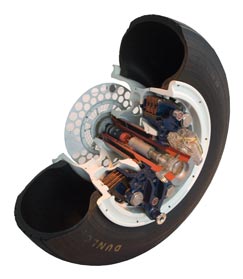In times of trouble, perhaps the best thing you can do is take a long hard look at what you do, how you do it and what tools you use. Al Dean thinks now is the perfect time to armour up for the battle ahead
Looking at the current state of affairs in the world’s economy, we’re facing the harshest climate for business that the world has seen in decades. Cash is drying up and the world of engineering, design and manufacture always gets hit hard when the going gets tough. And, by Christ, it’s looking rough out there these days. We’ve seen entire countries going tits up, the banking world is in complete turmoil, and if you read the news, as I’m sure we all do more-so now than ever before, there’s nary a glint of light at the end of what looks to be a long, dark tunnel ahead of us of all.
While it undoubtedly looks bad for all concerned, perhaps now is the best time to re-evaluate what we, as designers, engineers, as producers of products, do, how we do it and the tools we have at our disposal – and perhaps more than anything else, take a look at how far we’ve come. I was reminded of this recently when I took a wander around Cosford Air Museum, just a few short miles from where I live in the Midlands.

A cutaway model of an aircraft wheel, a true feat of engineering
I spent the first hour marvelling with schoolboyish glee at the range of distinctly mean looking aircraft on display and the joy of seeing that Mark I Spitfire in the metal, when the closest I got was a 1:15 scale Airfix kit and an urgent need for superglue solvent. But then I considered what I was looking at and came away with one single thought.
If such a wide range of innovation can be accomplished without the use of technologies we now take for granted – the invention of the jet engine, radar, nuclear power to name but a few – what potential is there today? A case in point is the display model of an aircraft landing wheel shown to the right. This cutaway model is the physical manifestation of years of development, using paper, pencils, hand calculations and sheer bloody expertise. Even to present the concept and workings of a seemingly innocuous but critical component, required that the model be built and cutaways created.
When you consider that with today’s tools, you could build the model in 3D, test it according to real world operating conditions, instigate design change at your whim and present that component, in a clear, understandable form, without ever having to physically manifest it, that’s a huge shift.
So if such ground breaking and breathtaking work that is the very definition of innovation, could be accomplished using, seemingly archaic tools, how was it possible? What was the catalyst to such rapid product development that saw things shift so dramatically?
If any group of global citizens can pull us back from the brink of the economic apocalypse, it’s designers and engineers – as we always have done
Now, I don’t ever intend to compare the climate of the forties and early fifties to the situation we find ourselves in now, but there is a lesson to be learned. When the chips are down, when things are bad and you’re under extreme pressure, you have one of two options. You can give up and kowtow to that pressure, hoping (probably in vain) that things will improve. Or, you can come out fighting. You can use your knowledge and expertise to shift what you do, to create better products, to create true innovations, to reassess everything and find a way to work more efficiently and intelligently and to find new areas to work in, new markets, new opportunity.
But how do you do this without resources, which for some companies are as scarce as they were back then? It’s all well and good me sitting here and trying to rally the troops to action, talking about rearming for the battle ahead, but when you’re facing economic meltdown, there are sometimes precious few resources available to buy in new technology.
However, what is worth considering is that there is probably a wealth of tools in your current toolset that you are simply not using or taking advantage of to the fullest. Take, for example, the bundling options available within the majority of modelling systems. I would bet there are tools there that have never been investigated and used in anger. How many users already have simulation, analysis, rendering and collaboration tools sat on their hard drives, but have never invested time in these technologies, or even used them at all? Perhaps now is the best time to take a good look, and see what they offer and re-assess your workflow.
If designers and engineers of the forties and fifties could achieve such innovative feats of engineering, then what could be accomplished now with the wealth of technology available at our fingerstips? Now is the perfect time to retool and get working, because if any group of global citizens can pull us back from the brink of the economic apocalypse, it’s designers and engineers – as we always have done. Let’s get cocked, locked, and ready to rock. Al Dean. Over and out.
{encode=”al@x3dmedia.com” title=”al@x3dmedia.com”}

Designers and engineers hold the key to the future, says Al Dean






